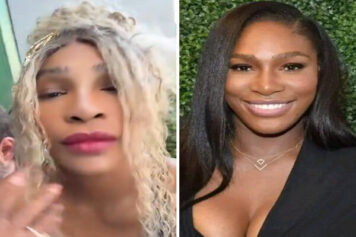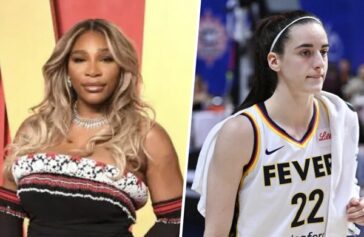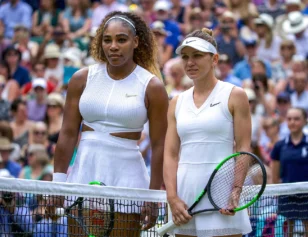On Saturday, Serena Williams won her 20th Grand Slam title with the capture of the 2015 French Open.
And it wasnt an easy road at all.
Battling the flu that nearly derailed her in the semis, Williams defeated Czechoslovakia’s Lucie Safarova, 6-3, 7-6(2), 6-2, enabling the world #1 ranked Williams to take another step closer to the all-time womens singles record of 24 held by the great Australian Margaret Court. With the latest win, shes only two victories behind Germanys Steffi Graf (22).
It was another drama-filled tournament for Williams. Dropping the first set in four of her seven matches, Williams had to battle not only her opponents, but her own body and mind as well. Suffering from the aforementioned flu-like symptoms in her semi-final match against Switzerlands Timea Bacsinszky, there were times when Williams was nearly in tears during changeovers. Coughing fits and achingly walking the baseline between points, its a wonder Williams made it to the final at all.
And that semi-final match brought what often seems to follow Serena- criticism.
Not only is serena one of the best women players of all time, she’s also one of the best actresses #suckitup#learnhowtolose#pathetic
Tara Moore (@TaraMoore92) June 4, 2015
Not taking away the fact that serena is amazing but if you feel that sick then stop! Could be dangerous! Bacsinzsky is playing amazing!!!
Tara Moore (@TaraMoore92) June 4, 2015
Great Britain’s Tara Moore received some backlash for her tweet (some that crossed the line), including from her fellow Brit, Laura Robson.
@TaraMoore92 I’m not convinced the pathetic hashtag can apply to one of the best players of all time? #19slams
Laura Robson (@laurarobson5) June 4, 2015
When players and teams rise to the top, there will always be haters. When youre the best, people will either love you or hate you. Respect you and your accomplishments or dis, suspect and doubt all that you do. Moore wouldn’t be the first tennis player or even person to criticize Serena for her behavior on the court some deserved (berating a line judge), some not (Crip Walk).
But there has always been another undercurrent of sentiment toward Serena, as well as her sister, Venus. It is one of race.
When the Williams sisters came along, they had not followed the traditional, staid ways of tennis. They grew up learning their tennis game on the courts of Compton, California not Boca Raton, Florida. Their father, Richard, was their coach, but not in the mold of a Stefano Capriati (Jennifer) or Walter Bartoli (Marion). Some might question his single-mindedness of viewing his daughters as future stars, but there was always Oracene (Venus and Serena’s mother) to balance him out.
They had their own way of doing things. Richard pulled the girls from the junior circuit that so many young tennis players grow up playing school, having a childhood should be the focus. They were unique in their training, upbringing and yes, even their tennis look.
BOOK END OF 20 SLAMS!! @serenawilliamspic.twitter.com/GYeyXzxTx1
rennae stubbs (@rennaestubbs) June 6, 2015
Beads in hair, sometimes wearing them on the court, they didn’t look like anyone else in tennis and nor did they play like it. Tall, athletic, powerful and unprecedented court coverage. Their lightning fast serves seemed other-wordly.
All from two African-American girls from Compton.
Women’s tennis had never seen anything like them before. The Williams sisters forced the rest of women’s tennis players to change. They forced them to improve their court coverage and service return game. They forced them to improve their endurance.
Not everyone embraced the change. As Mark Anthony Neal documented in this 2012 piece quoting Delia Douglas, Characterizations of their style of play rely on a very ancient grammar of black physicality to explain their athletic success.
Yes they were athletic, but they were also smart. They, like other athletes in other sports, continued to learn and improve their game. The Serena Williams of today is not the same one we saw 10 years ago. She is stronger physically and mentally two key elements for any sports great.
No, the Williams sisters weren’t like anyone else in tennis. Today, not even illness and injury-plagued Venus is like Serena.
Serena is on another level.
In today’s sports world, being on top usually leads to popularity and success off the field of play, which includes endorsements. Michael Jordan is considered the greatest basketball player ever by many fans and media. Be like Mike was the catch-phrase on people’s lips.
Being like Mike meant drinking Gatorade and wearing Air Jordans, one of the most dominant sneakers ever created. Theyre in such high demand that even the $100+ price tag didn’t deter people from scooping them up. The Air Jordan line is still a profitable venture for Nike and Jordan. According to Forbes, the Jordan line earned $2.6 billion in 2014 helping Jordan earn $100 million overall – 12 years after his (second) retirement. Every subsequent NBA star after Jordan has to have their own shoe line. LeBron, Curry, Durant and the list goes on.
In the argument of NBA GOAT, the debate rages between Jordan and LeBron. Jordan showed today’s generation how to become one’s own personal brand. Like Jordan, LeBron has a shoe deal with Nike, along with other major deals with companies such as McDonald’s, Beats by Dre, Samsung and Coca-Cola, as well as owning his own production company.
LeBron, like Jordan, is a brand, and a brand that sells. His on-court exploits and engaging personality off is extremely appealing to companies around the world, making him one of the most sought after endorsers in the world of sports.
But what of Serena the GOAT in her sport currently?
Serena may be #1 in the world and in the argument for greatest female tennis player ever, but that ranking doesn’t equate to major endorsements like Jordan and LeBron. In 2014, Williams ranked #3 on the list of highest paid female athletes. She lagged far behind her rival, Maria Sharapova, who ranked fourth in the world in tennis. Shrapova has been the highest paid female athlete for a decade. High-profile brands like Porsche, Tag Heuer and Nike are all part of the Sharapova portfolio.
With only five singles majors to her name, Sharapova isnt even close to Williams’ on-court prowess. Theyre both world class athletes, personable and engaging on camera. They both speak multiple languages and have strong business sense. Ideal candidates for sponsor appeal.
So what is it that draws advertisers and brands to Sharapova over Williams?
If all things were equal in terms of performance then Sharapova’s endorsement dominance could be rationalized. But all things are not equal. Williams holds a 17-2 head-to-head advantage over Sharapova. She has won more Grand Slam titles, more overall titles and with the exception of a few notable on-court incidents, a solid representative for the sport of tennis.
One can only speculate the reasons for the endorsement disparity. Physical appearance? Race? Background? Lifestyle? Personality? Sure, they all play a factor, but shouldnt the #1 ranked player in the world be dominant both on the court and in ads?
Not everyone likes Serena. Not everyone likes the greats. There will always be arguments over the GOAT in every sport: MJ or LeBron? Montana or Brady? Messi or Ronaldo? Howe or Gretzky? One person’s Hank Aaron is another person’s Barry Bonds.
We’re not privy to what happens in the locker room. Who knows what Tara Moore’s encounters with Serena have been. We do know that what we see in public isn’t always reality. Fellow American Sloane Stephens was quoted as such in 2013, They think she’s so friendly and she’s so this and she’s so that no that’s not reality!
Perhaps that plays into the endorsement disparity. Perhaps that plays into the G.O.A.T. argument. Is Serena the greatest women’s singles tennis player of all time? It’s all subjective; but with #20 in hand, she is well on her way. As Safarova’s coach, Rob Steckley, said in this New York Times article, Theres a reason why she has 20 Slams under her belt. Its something in her, something in the blood.
Something in her, indeed.
Greatness.
(Photo credit: Julian Finney/Getty Images)




